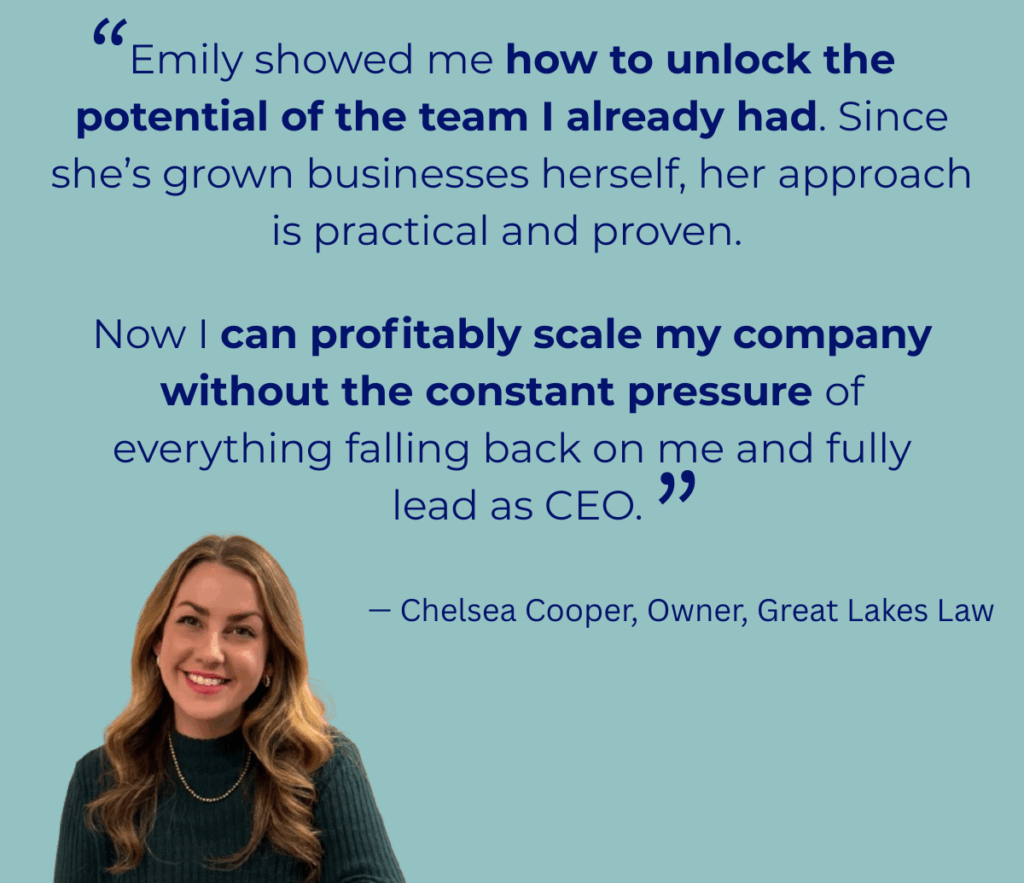Chelsea Cooper had built a thriving law practice, but every day felt like a trade-off between operational excellence and business development.
If she leaned into growth, things slipped in the office. If she stayed close to the operations, growth stalled.
It left her feeling stretched thin and constantly torn between two roles: one as full time lawyer and one as CEO and business owner.
The Challenge
Over time, that strain started showing up in the business itself. Team members looked to her for every decision, responsibilities overlapped and accountability blurred. Without consistently defined expectations, even her top performers couldn’t fully deliver at their best.
Chelsea had already invested in strong processes. The missing piece was aligning her people – her greatest asset – around clear roles and measurable goals.
The Approach
In just two months, we rolled out the infrastructure to improve performance and reduce the strain on Chelsea:
- Company Values Workshop– A firmwide session where every team member contributed to defining the values that guide how they show up for clients and for each other.
- Org Chart Redesign– Built a leadership layer beneath Chelsea to reduce her direct reports and create management opportunities for senior staff.
- Scorecards– Used the Topgrading methodology to develop role-specific scorecards with measurable expectations tied directly to company goals.
- Dashboards– Created operational dashboards linked to scorecard metrics that gave Chelsea and her leaders real-time visibility into performance and trends.
- Feedback Training Workshop– Equipped the leadership team with tools to provide clear, constructive feedback in real time.
This blend of structure and leadership development lays the foundation for what I call a culture of performance: where both the “what” and the “how” are clear and accountability becomes part of everyday operations. It’s the same playbook I used to scale my own SaaS companies, adapted for a professional services firm.
The Results
- Clearer roles, stronger results– People understood their roles and how success would be measured, which was reinforced by consistent feedback. With greater clarity, less landed back on Chelsea’s desk.
- Expanded leadership capacity– Senior staff stepped into management roles, reducing Chelsea’s load while creating career growth opportunities for them.
- Growth without extra cost– By optimizing the people already in place, the firm accelerated progress without adding headcount or overhead – driving growth and increased profitability at the same time. The firm can now take on more clients without expanding the team.
- CEO capacity restored– Chelsea gained the freedom to focus on strategy and growth as a true CEO, instead of being pulled into daily details.
- Clear next steps– With structure in place, the firm’s focus is shifting to an employee engagement survey and a performance management process to keep building momentum.
In Chelsea’s words:

The Takeaway
Businesses don’t scale just by adding people – they scale by creating the conditions for people to thrive. At Great Lakes Law, investing in the right structure transformed the firm into a faster, leaner, and more profitable business – with a culture that prioritizes individual accountability and performance without constant oversight.
And this isn’t unique to law. The same framework can be applied across industries, helping growth-minded companies scale profitably by accessing the full potential of their people.
If your business is growing but still depends too heavily on you, it’s time to invest in people infrastructure that drives performance and frees you to lead.
Book your free 20-minute strategy call here.